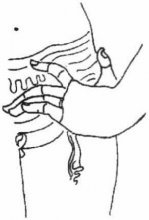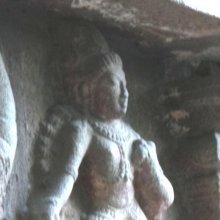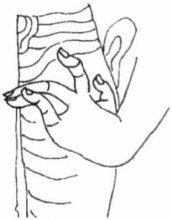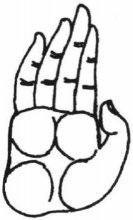Hasta, Hastā: 45 definitions
Introduction:
Hasta means something in Buddhism, Pali, Hinduism, Sanskrit, Jainism, Prakrit, the history of ancient India, Marathi, Hindi. If you want to know the exact meaning, history, etymology or English translation of this term then check out the descriptions on this page. Add your comment or reference to a book if you want to contribute to this summary article.
Alternative spellings of this word include Hast.
Images (photo gallery)
(+158 more images available)
In Hinduism
Natyashastra (theatrics and dramaturgy)
Source: Wisdom Library: Nāṭya-śāstraHasta (हस्त) refers to “hands”. It is one of the six major limbs (aṅga) used in dramatic performance, according to the Nāṭyaśāstra chapter 8. With these limbs are made the various gestures (āṅgika), which form a part of the histrionic representation (abhinaya).
Source: archive.org: The mirror of gesture (abhinaya-darpana)The Classification of Hands (hasta-bheda).—The characteristics of the Hands will be set forth in order. There are two kinds,
- the Single (asamyutta)
- and the combined (samyutta).
There are twenty-eight Single Hands as follows:
- Patāka,
- Tripatāka,
- Ardha-patāka,
- Kartarī-mukha,
- Mayura,
- Ardha-candra,
- Arāla,
- Śuka-tuṇḍaka,
- Muṣṭi,
- Śikhara,
- Kapittha,
- Kaṭaka-mukha,
- Sūci,
- Candra-kalā,
- (Padma-) Kośa,
- Sarpa-śīrṣa,
- Mṛga-śīrṣa,
- Siṃha-mukha,
- Lāṅgula,
- Sola-padma,
- Catura,
- Bhramara,
- Haṃsāsya,
- Haṃsa-pakṣa,
- Saṃdaṃsa,
- Mukula,
- Tāmracūḍa,
- Triśūla.
Thus the Twenty-eight Hands are set forth. But it is said that there are as many hands as meanings.
According to another text (three others are mentioned, as follows):
- Urṇa-nābha (spider),
- Bāṇa (arrow)
- and Ardha-sūcika (half-needle).
1) Hasta (हस्त, “palms”) refers to one of the seven “major limbs” (aṅga), which represents a division of Āṅgikābhinaya (gesture language of the limbs) as used within the classical tradition of Indian dance and performance, also known as Bharatanatyam.—Āṅgika-abhinaya is the gesture language of the limbs. Dance is an art that expresses itself through the medium of body, and therefore, āṅgikābhinaya is essential for any dance and especially for any classical dance of India. Aṅgas or major limbs include the head, hands (viz., Hasta), chest, sides, waist, and feet; at times the neck is also used as a separate limb.
2) Hasta (हस्त, “palms”) means “hand”. Hasta-bheda means different movements or gestures of the hand. Hastas follow a dance convention. They are created for the purpose of communication through dance. Each of the hastas can be used to denote various thoughts, ideas, and objects. There are various ślokas (verses) from the ancient texts that enumerate and describe the usage of the hastas. These are called viniyogaślokas. When a hasta is placed differently at different levels, the meaning also changes. Hastas are highly symbolic and suggestive. Apart from the viniyogas (usage) suggested, the dancer may innovate, if found necessary, to convey the appropriate message to the audience.
The hastas are of two categories. They are the asaṃyuta-hastas (single hand gestures) and the saṃyuta-hastas (double hand gestures). There are nṛtta-hastas (the combined hand gestures pertaining to dance) found in dance. But these hastas are not used often in Bharatanatyam.
Source: Shodhganga: Elements of Art and Architecture in the Trtiyakhanda of the Visnudharmottarapurana (natya)Hasta (हस्त) or Hastamudrā refers to “hand gestures” (in Indian Dramas), according to the Viṣṇudharmottarapurāṇa, an ancient Sanskrit text which (being encyclopedic in nature) deals with a variety of cultural topics such as arts, architecture, music, grammar and astronomy.—The hand postures are termed as hastamudrās in Sanskrit. The hasta-mudrās are very essential to denote some particular action or state in dancing and these mudrās are formed with the help of hands and fingers. In the Viṣṇudharmottarapurāṇa the necessity of hand gestures are highly recommended as according to this book, Dance depends on the actions of the hands.
In the Viṣṇudharmottarapurāṇa mainly three kinds of hasta-mudrās are discussed and those are termed as hasta:—
- asaṃyukta-hasta,
- saṃyukta-hasta and
- nṛtta-hasta.

Natyashastra (नाट्यशास्त्र, nāṭyaśāstra) refers to both the ancient Indian tradition (shastra) of performing arts, (natya—theatrics, drama, dance, music), as well as the name of a Sanskrit work dealing with these subjects. It also teaches the rules for composing Dramatic plays (nataka), construction and performance of Theater, and Poetic works (kavya).
Purana and Itihasa (epic history)
Source: Google Books: Cultural History from the Vāyu PurānaHasta (हस्त): A unit of measurement of distance, according to the Vāyu Purāṇa (वायु पुराण). The following table gives some idea about their relations to each other:
|
8 Aṅgulas = Prādeśa (?); 21 Aṅgulas = Ratni; 24 Aṅgulas = Hasta; 2000 Dhanus = Gavyūti; |
12 Aṅgulas = Vitasti; 2 Ratnis or 42 Aṅgulas = Kiṣku; 4 hastas = Dhanus; 8000 Dhanus = Yojana. |
1a) Hasta (हस्त).—A son of Rocana and Vasudeva.*
- * Bhāgavata-purāṇa IX. 24. 49.
1b) A son of Sāvarṇa Manu I.*
- * Brahmāṇḍa-purāṇa IV. 1. 64.
1c) A measurement of 24 angulas.*
- * Vāyu-purāṇa 8. 102, 105; 101. 123.
1d) A son of Haryaśva and father of Sumanas.*
- * Viṣṇu-purāṇa IV. 3. 19-20.
1e) A constellation;1 śrāddham that day makes one important in an assembly.2

The Purana (पुराण, purāṇas) refers to Sanskrit literature preserving ancient India’s vast cultural history, including historical legends, religious ceremonies, various arts and sciences. The eighteen mahapuranas total over 400,000 shlokas (metrical couplets) and date to at least several centuries BCE.
Jyotisha (astronomy and astrology)
Source: Wisdom Library: JyotiṣaHasta (हस्त):—Name for a particular section of the ecliptic. It is also known as Hastanakṣatra. Nakṣatra means “Lunar mansion” and corresponds to a specific region of the sky through which the moon passes each day. Hasta means “the hand” and is associated with the deity known as Savitā (God of awakening). The presiding Lord of this lunar house is Chandra (Moon).
Indian zodiac: |10°| – |23°20' Kanyā|
Kanyā (कन्या, “girl”) corresponds with Virgo.
Western zodiac: |6°| – |19°20' Libra|
Libra corresponds with Tulā (तुला, “balance”).
Hasta (हस्त).—Cubit, measure of length. Note: Hasta is a Sanskrit technical term used in ancient Indian sciences such as Astronomy, Mathematics and Geometry.

Jyotisha (ज्योतिष, jyotiṣa or jyotish) refers to ‘astronomy’ or “Vedic astrology” and represents the fifth of the six Vedangas (additional sciences to be studied along with the Vedas). Jyotisha concerns itself with the study and prediction of the movements of celestial bodies, in order to calculate the auspicious time for rituals and ceremonies.
Yoga (school of philosophy)
Source: Wisdom Library: YogaHasta (हस्त) is a Sanskrit word referring to the “hand”. It is one of the fourteen Adhyātma (pertaining to the body) mentioned in the Subālopaniṣad (fifth section). The corresponding Ādhibhūta (pertaining to the elements) is called ādātavya (that which can be handled) and the corresponding Adhidaivata (presiding deity) is indra. Accordingly, “the nādis form their bond (or connect them). He who moves in the hand (hasta), in ādātavya, in indra, in the nādis, in prāṇa, in vijñāna, in ānanda, in the ākāśa of the heart and within all else—That is Ātman. It is that which should be worshipped. It is without old age, death, fear, sorrow or end.”

Yoga is originally considered a branch of Hindu philosophy (astika), but both ancient and modern Yoga combine the physical, mental and spiritual. Yoga teaches various physical techniques also known as āsanas (postures), used for various purposes (eg., meditation, contemplation, relaxation).
Vastushastra (architecture)
Source: Wisdom Library: Vāstu-śāstraHasta (हस्त) refers to the thirteenth of twenty-seven constellations (ṛkṣa), according to the Mānasāra. Ṛkṣa is the third of the āyādiṣaḍvarga, or “six principles” that constitute the “horoscope” of an architectural or iconographic object. Their application is intended to “verify” the measurements of the architectural and iconographic object against the dictates of astrology that lay out the conditions of auspiciousness.
The particular nakṣatra, also known as ṛkṣa (e.g., hasta) of all architectural and iconographic objects (settlement, building, image) must be calculated and ascertained. This process is based on the principle of the remainder. An arithmetical formula to be used in each case is stipulated, which engages one of the basic dimensions of the object (breadth, length, or perimeter/circumference). In the context of village planning and measurement, the text sates that among the stars (ṛkṣa), the ones that are pūrṇa (odd), are auspicious and the ones that are karṇa (even), inauspicious.
Source: OpenEdition books: Architectural terms contained in Ajitāgama and RauravāgamaHasta (हस्त) refers to “running cubit of 24 fingers § 2.1.”.—(For paragraphs cf. Les enseignements architecturaux de l'Ajitāgama et du Rauravāgama by Bruno Dagens)
Source: Brill: Śaivism and the Tantric Traditions (architecture)Hasta (हस्त) refers to a basic unit of measurement in house construction, according to early Śaiva texts (such as the Mohacūrottara and the Devyāmata).—Measurements are made in hastas, hands, a measure from the elbow to the tip of the middle finger of the patron. Those measurements are checked for their āya. The āyas are formulae used to test measurements, to ensure that they are suitable for use. A common presentation is of six sets of āyas: āya, vyaya, ṛkṣa, yoni, vāra, and tithi or aṃśa. [...]
Source: Shodhganga: Elements of Art and Architecture in the Trtiyakhanda of the Visnudharmottarapurana (vastu)Hasta (हस्त) or “hand” refers to a commonly used unit of measurement in the construction of Temples and other buildings, according to the Viṣṇudharmottarapurāṇa, an ancient Sanskrit text which (being encyclopedic in nature) deals with a variety of cultural topics such as arts, architecture, music, grammar and astronomy.—The Measurement used in the construction of every part of the Temple is done with hasta i.e., hand. The dimension of the construction of the whole process is basically based on the measurement in terms of hasta. Different parts of Hindu temple are discussed here focusing on the discussion found in the Viṣṇudharmottarapurāṇa.

Vastushastra (वास्तुशास्त्र, vāstuśāstra) refers to the ancient Indian science (shastra) of architecture (vastu), dealing with topics such architecture, sculpture, town-building, fort building and various other constructions. Vastu also deals with the philosophy of the architectural relation with the cosmic universe.
Shilpashastra (iconography)
Source: archive.org: Illustrations of Indian Music and Dance in Western Indian StyleHasta (हस्त) refers to one of the forty-seven tānas (tone) used in Indian music.—The illustration of Hasta (as a deity) according to 15th-century Indian art is as follows.—The colour of his body is yellow. His face is similar to the face of a cuckoo. A viṇā is held with both hands.
The illustrations (of, for example Hasta) are found scattered throughout ancient Jain manuscripts from Gujarat. The descriptions of these illustrations of this citrāvalī are based on the ślokas of Vācanācārya Gaṇi Sudhākalaśa’s Saṅgītopaniṣatsāroddhāra (14th century) and Śārṅgadeva’s Saṅgītaratnākara (13th century).
Source: Shodhganga: The significance of the mūla-beras (śilpa)Hasta (हस्त) and Mudrā both refer to “gestures” (made with the hand), and forms one of the three divisions of pratimālakṣaṇa (body postures of the icons), as defined according to texts dealing with śilpa (arts and crafs), known as śilpaśāstras.—The technical term used in the texts to denote the finger poses is mudrā and hasta. The term hasta is generally used in cases where the whole of the arm along with the hand is shown in a particular pose. The term mudrā usually denotes the peculiar posture in which the palm with the fingers is shown. Hastas and mudrās thus usually indicate some action, which the god or his attendant is shown to be engaged in. The action consists of the expression of an idea by means of a particular gesture.
Source: Shodhganga: Vaisnava Agamas And Visnu ImagesHasta (हस्त) or Mudrā refers to “hand gestures”, as defined in treatises such as the Pāñcarātra, Pādmasaṃhitā and Vaikhānasa-āgamas, extensively dealing with the technical features of temple art, iconography and architecture in Vaishnavism.—The hand-gestures called hasta or mūdra symbolizes some meaning and they play an important role in sculptures as well as dancing and rituals. The hastas or mūdras found in the Pāñcarātra texts are two types—a) used for ritualistic purposes and b) applied in the iconography. The former is meant for the invocation of the divinities and invocation of the special features in the divine forms both manifest (iconic representation) and unmanifest (pitcher, diagram, and fire altar). The latter is of three types—a) to convey some meaning, b) functional (holding attribute), and, c) for beautification and aesthetic balance.
Banerjea observes, “The technical term, used in the texts to denote these poses, is mudā; sometimes the word hasta is also used to denote one or other of these hand-poses. [...] Hasta is generally used in cases where the whole of the arm along with the hand is shown in a particular pose (cf. daṇḍahasta, gajahasta, kaṭihasta, etc.). [...] Sometimes, though comparatively rarely, both the terms are used in the texts to signify particular hand-poses; thus, in iconographic parlance, abhaya-mudrā and abhaya-hasta and varada-mudrā and varada-hasta are equally appropriate”.

Shilpashastra (शिल्पशास्त्र, śilpaśāstra) represents the ancient Indian science (shastra) of creative arts (shilpa) such as sculpture, iconography and painting. Closely related to Vastushastra (architecture), they often share the same literature.
Shaivism (Shaiva philosophy)
Source: Shodhganga: Iconographical representations of ŚivaHasta (हस्त) or Hastāgama refers to one of upāgamas (supplementary scriptures) of the Sahasrāgama which is one of the twenty-eight Siddhāntāgama: a classification of the Śaiva division of Śaivāgamas. The Śaivāgamas represent the wisdom that has come down from lord Śiva, received by Pārvatī and accepted by Viṣṇu. The purpose of revealing upāgamas (e.g., Hasta Āgama) is to explain more elaborately than that of mūlāgamas (e.g., Sahasra-āgama) and to include any new idea if not dealt in mūlāgamas.
Source: Brill: Śaivism and the Tantric TraditionsHasta (हस्त) refers to the “trunk (of an elephant)”, according to the 13th-century Matsyendrasaṃhitā: a Kubjikā-Tripurā oriented Tantric Yoga text of the Ṣaḍanvayaśāmbhava tradition from South India.—Accordingly, “[The intercourse (saṃga)]:—The Yogin should embrace and kiss her, etc., properly. [Then] he should have sex with her outwardly, very gently, while [performing] visualisation. He should apply the ‘elephant trunk’ (gaja-hasta) [method] on her divine love temple [i.e. her genitalia]. [...]

Shaiva (शैव, śaiva) or Shaivism (śaivism) represents a tradition of Hinduism worshiping Shiva as the supreme being. Closely related to Shaktism, Shaiva literature includes a range of scriptures, including Tantras, while the root of this tradition may be traced back to the ancient Vedas.
Ayurveda (science of life)
Source: gurumukhi.ru: Ayurveda glossary of termsHasta (हस्त):—[hastaḥ] Hand

Āyurveda (आयुर्वेद, ayurveda) is a branch of Indian science dealing with medicine, herbalism, taxology, anatomy, surgery, alchemy and related topics. Traditional practice of Āyurveda in ancient India dates back to at least the first millenium BC. Literature is commonly written in Sanskrit using various poetic metres.
Shaktism (Shakta philosophy)
Source: Google Books: ManthanabhairavatantramHasta (हस्त) or Hastamudrā is the name of the Gesture (mudrā) associated with Kāmarūpa, one of the sacred seats (pīṭha), according to the Ṣaṭsāhasrasaṃhitā, an expansion of the Kubjikāmatatantra: the earliest popular and most authoritative Tantra of the Kubjikā cult.—On the basis of hardly more than a hint in the Ṣaṭsāhasrasaṃhitā, it outlines a scheme of sixteen parts for each seat, conscious, no doubt, that this is an ideal number. The commentary normally limits itself to do no more than explain what is presented in the text. This is one of the few instances it adds substantially to its contents [i.e., the Gestures—Hasta]. Presumably this is because when it was written the presentation of the features of the seats on this model was the accepted norm.

Shakta (शाक्त, śākta) or Shaktism (śāktism) represents a tradition of Hinduism where the Goddess (Devi) is revered and worshipped. Shakta literature includes a range of scriptures, including various Agamas and Tantras, although its roots may be traced back to the Vedas.
Sports, Arts and Entertainment (wordly enjoyments)
Source: archive.org: Syainika Sastra of Rudradeva with English Translation (art)Hasta (हस्त) or Hastamoka refers to one of the two methods of “casting” (or “throwing”) Hawks, according to the Śyainika-śāstra: a Sanskrit treatise dealing with the divisions and benefits of Hunting and Hawking, written by Rājā Rudradeva (or Candradeva) in possibly the 13th century.—Accordingly, “The casting [of hawks] is of two kinds—hasta-moka and muṣṭi-moka. [...] Hasta-moka is that in which the jesses of the hawk are held by the fingers and the hawk is cast at the quarry, This is the only method in the case of Kuhīs (Shahin), and one of the best in the case of the Bāsā (Sparrow-hawk)”.

This section covers the skills and profiencies of the Kalas (“performing arts”) and Shastras (“sciences”) involving ancient Indian traditions of sports, games, arts, entertainment, love-making and other means of wordly enjoyments. Traditionally these topics were dealt with in Sanskrit treatises explaing the philosophy and the justification of enjoying the pleasures of the senses.
General definition (in Hinduism)
Source: Wisdom Library: HinduismHasta; ancient Hindu unit of measurement of distance. 24 Aṅgulas make 1 Hasta, and 4 Hastas make up for a single Dhanu.
If we consider a single Yojana to be 8 miles (~12.87km), one Hasta would correspond to roughly 1.32 feet (~40.23cm)
If we consider a single Yojana to be 5 miles (~8.04km), one Hasta would correspond to roughly 9.9 inches (~25.15cm)
Source: archive.org: Vedic index of Names and SubjectsHasta (हस्त, ‘hand’) is made up of the five conspicuous stars (δ, γ, ε, α, β) in Corvus, a number which the word itself suggests. According to Geldner, the ‘five bulls of the Rigveda are this constellation.
Source: WikiPedia: HinduismThe hasta is a traditional Indian unit of length, measured from the elbow to the tip of the middle finger. It equals 24 aṅgulas orᅠ about 18 inches, about 45 centimetres.
400 hastas make one nalva.
Etymology: The hasta (Sanskrit: हस्त (hasta); Chinese: 肘 (pinyin: zhǒu))
In Buddhism
Mahayana (major branch of Buddhism)
Source: Wisdom Library: Maha Prajnaparamita Sastra1) Hasta (हस्त, “hand”) refers to that part of the human body from which the Buddha emitted numerous rays when he smiled with his whole body after contemplating the entire universe, according to the 2nd century Mahāprajñāpāramitāśāstra (chapter XIV).—Accordingly, having himself arranged the lion-seat, the Bhagavat sat down cross-legged; holding his body upright and fixing his attention, he entered into the samādhirājasamādhi. Then, having tranquilly come out of this samādhi and having contemplated the entire universe with his divine eye (divyacakṣus), the Bhagavat smiled with his whole body. Wheels with a thousand spokes imprinted on the soles of his feet (pādatala) shoot out six hundred prabhedakoṭi of rays. In the same way, beams of six hundred prabhedakoṭi of rays are emitted from his hands (hasta).
2) Hasta (हस्त) refers to one of the twenty-seven constellations (nakṣatra) according to according to Mahāprajñāpāramitāśāstra (chapter XIV).—Hasta is the Sanskrit equivalent of Chinese Tchen, Tibetan Me-bzhi and modern Corvi.
Hasta is classified in the third group: “The moon revolves around the earth in 28 days. If the moon enters one of the six following constellations (e.g., Hasta), then at that moment the earth trembles as if it would collapse, this trembling extends as far as the Garuḍa. Then there is no more rain, the rivers dry up, the year is bad for grain, the emperor (T’ien tseu) is cruel and the great ministers are unjust”.
Source: archive.org: Bulletin of the French School of the Far East (volume 5)Hasta (हस्त) is the name of a Nakṣatra mentioned in chapter 18 of the Candragarbha: the 55th section of the Mahāsaṃnipāta-sūtra, a large compilation of Sūtras (texts) in Mahāyāna Buddhism partly available in Sanskrit, Tibetan and Chinese.—Chapter 18 deals with geographical astrology and, in conversation with Brahmarāja and others, Buddha explains how he entrusts the Nakṣatras [e.g., Hasta] with a group of kingdoms for the sake of protection and prosperity.
The Hastanakṣatra comprises the following realms:
- Kia-lo-p'o-[lo] (Garava or Garavala),
- Yeou-lo-chö (Uraśa),
- Ki-che-na (Kaśina?),
- P'o-ki (Vagi?),
- T'an-to-mo-li (Dandamari?),
- P'o-leou-tchö (Baruca?),
- P'o-tch'a (Daṭa?),
- Ta-na (Dhana?),
- Chou-meou-ki-chö (Śumukeśa?),
- Kieou-louen-tchö-tch'a (Kuruṃcakṣa?),
- K'ia-lo-p'o-lo (Kharavala?),
- A-chou-kiu-kia (Aśukoka?).

Mahayana (महायान, mahāyāna) is a major branch of Buddhism focusing on the path of a Bodhisattva (spiritual aspirants/ enlightened beings). Extant literature is vast and primarely composed in the Sanskrit language. There are many sūtras of which some of the earliest are the various Prajñāpāramitā sūtras.
Tibetan Buddhism (Vajrayana or tantric Buddhism)
Source: Wisdom Library: Tibetan BuddhismHastā (हस्ता) refers to one of the various Nakṣatras mentioned as attending the teachings in the 6th century Mañjuśrīmūlakalpa: one of the largest Kriyā Tantras devoted to Mañjuśrī (the Bodhisattva of wisdom) representing an encyclopedia of knowledge primarily concerned with ritualistic elements in Buddhism. The teachings in this text originate from Mañjuśrī and were taught to and by Buddha Śākyamuni in the presence of a large audience (including Hastā).
Source: archive.org: The Indian Buddhist IconographyHastā (हस्ता) refers to the thirteenth of the 28 nakṣatras (“constellations”) of the zodiac, as commonly depicted in Buddhist Iconography, and mentioned in the 11th-century Niṣpannayogāvalī of Mahāpaṇḍita Abhayākara.—The nakṣatras are described collectively in the dharmadhātuvāgīśvara-maṇḍala of the Niṣpannayogāvalī. In this maṇḍala the nakṣatras are given one face and two arms, which are clasped against the chest in the añjalimudrā:—“the deities [viz., Hastā] are decked in bejewelled jackets and they all show the añjali-mudrā”.—In colour, however, they differ. [viz., Hastā is given the colour white].

Tibetan Buddhism includes schools such as Nyingma, Kadampa, Kagyu and Gelug. Their primary canon of literature is divided in two broad categories: The Kangyur, which consists of Buddha’s words, and the Tengyur, which includes commentaries from various sources. Esotericism and tantra techniques (vajrayāna) are collected indepently.
In Jainism
General definition (in Jainism)
Source: archive.org: Een Kritische Studie Van Svayambhūdeva’s PaümacariuHasta (हस्त) participated in the war between Rāma and Rāvaṇa, on the side of the latter, as mentioned in Svayambhūdeva’s Paumacariu (Padmacarita, Paumacariya or Rāmāyaṇapurāṇa) chapter 57ff. Svayambhū or Svayambhūdeva (8th or 9th century) was a Jain householder who probably lived in Karnataka. His work recounts the popular Rāma story as known from the older work Rāmāyaṇa (written by Vālmīki). Various chapters [mentioning Hasta] are dedicated to the humongous battle whose armies (known as akṣauhiṇīs) consisted of millions of soldiers, horses and elephants, etc.
Source: archive.org: TrisastisalakapurusacaritraHasta (हस्त) is the name of a warrior fighting on Rāvaṇa’s side, according to the Jain Ramayana and chapter 7.7 [The killing of Rāvaṇa] of Hemacandra’s 11th century Triṣaṣṭiśalākāpuruṣacaritra: an ancient Sanskrit epic poem narrating the history and legends of sixty-three illustrious persons in Jainism.—Accordingly, “[...] When Kākutstha was nearby, like Saturn in Pisces, Laṅkā trembled in every direction, fearing the end of the world. Rāvaṇa’s vassals armed themselves for battle, Hasta, Prahasta, Mārīca, Sāraṇa, and others by the thousand. Rāvaṇa, expert in beating enemies, had the cruel battle-drums beaten by the crore by servants. [...]”.
Source: OpenEdition books: VividhatīrthakalpaḥHasta (हस्त) refers to a unity of measurement corresponding to 24 aṅgula (roughly 40 cm), and represents a Jaina technical term mentioned in the Vividhatīrthakalpa by Jinaprabhasūri (13th century A.D.): an ancient text devoted to various Jaina holy places (tīrthas).

Jainism is an Indian religion of Dharma whose doctrine revolves around harmlessness (ahimsa) towards every living being. The two major branches (Digambara and Svetambara) of Jainism stimulate self-control (or, shramana, ‘self-reliance’) and spiritual development through a path of peace for the soul to progess to the ultimate goal.
India history and geography
Source: Cologne Digital Sanskrit Dictionaries: Indian Epigraphical GlossaryHasta.—(IE 8-6), a cubit (24 aṅgulas); sometimes regarded as 36 aṅgulas (27 inches), 20(3/4) inches, 34 inches, etc., in length; cf. Śivacandra-hasta, ‘the cubit measured according to the length of the forearm of Śivacandra’ (cf. ghaḻe). (EI 23; SII 2), a square cubit; a land measure. (Ep. Ind., Vol XIV, p. 366 and note), probably the same as pakṣa, ‘a fortnight’. Note: hasta is defined in the “Indian epigraphical glossary” as it can be found on ancient inscriptions commonly written in Sanskrit, Prakrit or Dravidian languages.

The history of India traces the identification of countries, villages, towns and other regions of India, as well as mythology, zoology, royal dynasties, rulers, tribes, local festivities and traditions and regional languages. Ancient India enjoyed religious freedom and encourages the path of Dharma, a concept common to Buddhism, Hinduism, and Jainism.
Languages of India and abroad
Marathi-English dictionary
Source: DDSA: The Molesworth Marathi and English Dictionaryhasta (हस्त).—m (S) A hand. 2 A cubit measured by the hand and arm, or from the elbow to the tip of the middle finger. 3 An elephant's trunk. 4 Used plurally. The thirteenth lunar asterism, designated by a hand. 5 A block or piece of wood inserted between the top of a post and the mass which it supports. 6 A term at chess. Used, as a, ad or interj, of that mode of playing in which a piece once touched by the hand must be played.
Source: DDSA: The Aryabhusan school dictionary, Marathi-Englishhasta (हस्त).—m A hand. The 13th lunar asterism. An elephant's trunk.
Marathi is an Indo-European language having over 70 million native speakers people in (predominantly) Maharashtra India. Marathi, like many other Indo-Aryan languages, evolved from early forms of Prakrit, which itself is a subset of Sanskrit, one of the most ancient languages of the world.
Sanskrit dictionary
Source: DDSA: The practical Sanskrit-English dictionaryHasta (हस्त).—[has-tan na iṭ Uṇādi-sūtra 3.86]
1) The hand; हस्तं गत (hastaṃ gata) 'fallen in the hand or possession of'; गौतमीहस्ते विसर्जयि- ष्यामि (gautamīhaste visarjayi- ṣyāmi) Ś.3 'I shall send it by Gautamī'; so हस्ते पतिता (haste patitā); हस्तसंनिहितां कुरु (hastasaṃnihitāṃ kuru) &c.; शंभुना दत्तहस्ता (śaṃbhunā dattahastā) Meghadūta 62 'leaning on Śambhu's hand'; हस्ते-कृ (haste-kṛ)
1) (hastekṛtya-kṛtvā) 'to take or seize by the hand, take hold of the hand, take in hand, take possession of'; Prov. :--हस्तकङ्कणं किं दर्पणे प्रेक्ष्यते (hastakaṅkaṇaṃ kiṃ darpaṇe prekṣyate) Karpūr. 'sight requires no mirror'.
2) The truck of an elephant; Kumārasambhava 1.36; अथवा हस्तिहस्तचञ्चलानि पुरुषभाग्यानि भवन्ति (athavā hastihastacañcalāni puruṣabhāgyāni bhavanti) Avimārakam 2.
3) Name of the 13th lunar mansion consisting of five stars.
4) The fore-arm, cubit, a measure of length (equal to 24 aṅgulas or about 18 inches, being the distance between the elbow and the tip of the middle finger).
5) Hand-writing, signature; धनी वोपगतं दद्यात् स्वहस्तपरिचिह्नितम् (dhanī vopagataṃ dadyāt svahastaparicihnitam) Y.1.319; स्वहस्त- कालसंपन्नं शासनम् (svahasta- kālasaṃpannaṃ śāsanam) 1.32 'bearing date and signature'; धार्यतामयं प्रियायाः स्वहस्तः (dhāryatāmayaṃ priyāyāḥ svahastaḥ) V.2 'the autograph of my beloved'; 2.2.
6) (Hence fig.) Proof, indication; Mu.3.
7) Help, assistance, support; वात्या खेदं कृशाङ्ग्याः सुचिरमवयवैर्दत्तहस्ता करोति (vātyā khedaṃ kṛśāṅgyāḥ suciramavayavairdattahastā karoti) Ve.2.21.
8) A mass, quantity, abundance (of hair), in comp. with केश, कच (keśa, kaca) &c.; पाशः पक्षश्च हस्तश्च कलापार्थाः कचात् (pāśaḥ pakṣaśca hastaśca kalāpārthāḥ kacāt) Ak.; रतिविगलितबन्धे केशहस्ते सुकेश्याः सति कुसुमसनाथे किं करोत्यषे वहीं (rativigalitabandhe keśahaste sukeśyāḥ sati kusumasanāthe kiṃ karotyaṣe vahīṃ) V.4.22.
-stam 1 A pair of leather-bellows.
2) Skill (in using the hand); कलासु कौशलमक्षभूमिहस्तादिषु (kalāsu kauśalamakṣabhūmihastādiṣu) Dk. 2.2.
Derivable forms: hastaḥ (हस्तः).
--- OR ---
Hastā (हस्ता).—The thirteenth lunar mansion.
Source: Cologne Digital Sanskrit Dictionaries: Edgerton Buddhist Hybrid Sanskrit DictionaryHasta (हस्त).—(1) nt. (= Sanskrit m.), hand: hastāni Mahāvastu i.18.2; haste (dual) 22.11 (both prose); (2) (m.; = Sanskrit hastaka, [Boehtlingk] s.v. 1 f; Pali hattha), handful: sotpalahastena (read with v.l. utpala°; compare 10 above, utpalahastakena)… vāhyamānau Lalitavistara 381.18 (prose), with a handful of lotuses being urged to drag (the carts); (3) (m.; = Pali hattha; compare hastaka) fan, see s.v. mayūra-hasta(ka).
Source: Cologne Digital Sanskrit Dictionaries: Shabda-Sagara Sanskrit-English DictionaryHasta (हस्त).—m.
(-staḥ) 1. The hand. 2. An elephant’s trunk. 3. The thirteenth lunar asterism, designated by a hand, and containing five stars. 4. A cubit measured by the hand and arm, or from the elbow to the tip of the middle finger, (equal to about eighteen inches.) 5. (In prosody,) An anapæst. 6. Possession, (figuratively.) 7. Handwriting, signature. 8. Abundance, mass; (in this sense it is used only at the end of compounds and implies “excellence,” “abundance,” &c., as keśahasta means, “A head of hair,” or “Abundance of hair,” &c.) n.
(-staṃ) A bellows. f.
(-stā) The thirteenth lunar asterism. E. has to laugh, Unadi aff. tan .
Source: Cologne Digital Sanskrit Dictionaries: Benfey Sanskrit-English DictionaryHasta (हस्त).—I. m. 1. The hand, [Vikramorvaśī, (ed. Bollensen.)] 27, 3. 2. An elephant’s trunk, [Meghadūta, (ed. Gildemeister.)] 14; [Hiḍimbavadha] 3, 9. 3. A multitude, after words signifying ‘hair.’ 4. A cubit, or measure extending from the elbow to the little finger, Böhtl. Ind. Spr. 3348. Ii. m., f. tā, The thirteenth lunar asterism. Iii. n. A bellows.
--- OR ---
Hāsta (हास्त).—i. e. hasta + a, adj. Formed by the hands (with mukula = añjali, humble salutation), [Nalodya, (ed. Benary.)] 1, 38.
Source: Cologne Digital Sanskrit Dictionaries: Cappeller Sanskrit-English DictionaryHasta (हस्त).—[masculine] hand (also as a measure of length), trunk (of an elephant), paw (of a tiger) etc., [Name] of [several] men & a lunar mansion; [adjective] —° holding in the hand (cf. pāṇi); [feminine] hastā hand.
Source: Cologne Digital Sanskrit Dictionaries: Monier-Williams Sanskrit-English Dictionary1) Hasta (हस्त):—m. (ifc. f(ā). , of unknown derivation) the hand (ifc. = ‘holding in or by the hand’; haste √kṛ [as two words], ‘to take into the hand’, ‘get possession of’; haste-√kṛ [as a [compound]], ‘to take by the hand, marry’; śatru-hastaṃ √gam, ‘to fall into the hand of the enemy’), [Ṛg-veda] etc. etc.
2) an elephant’s trunk (ifc. = ‘holding with the trunk’), [Aitareya-brāhmaṇa; Mahābhārata] etc.
3) the fore-arm (a measure of length from the elbow to the tip of the middle finger, = 24 Aṅgulas or about 18 inches), [Varāha-mihira’s Bṛhat-saṃhitā; Rājataraṅgiṇī] etc.
4) the position of the hand (= hasta-vinyāsa), [Vājasaneyi-saṃhitā-prātiśākhya]
5) hand-writing, [Yājñavalkya; Vikramorvaśī]
6) the 11th (13th) lunar asterism (represented by a hand and containing five stars, identified by some with part of the constellation Corvus), [Atharva-veda] etc. etc.
7) a species of tree, [cf. Lexicographers, esp. such as amarasiṃha, halāyudha, hemacandra, etc.]
8) (in prosody) an anapest, [Colebrooke]
9) quantity, abundance, mass (ifc. after words signifying ‘hair’; cf. keśa-h)
10) Name of a guardian of the Soma, [Sāyaṇa]
11) of a son of Vasudeva, [Bhāgavata-purāṇa]
12) of another man, [Rājataraṅgiṇī]
13) Hastā (हस्ता):—[from hasta] f. the hand, [Atharva-veda xi, 124]
14) [v.s. ...] the Nakṣatra Hasta, [Purāṇa]
15) Hasta (हस्त):—n. a pair of leather bellows, [cf. Lexicographers, esp. such as amarasiṃha, halāyudha, hemacandra, etc.]
16) mfn. born under the Nakṣatra Hasta, [Pāṇini 4-3,34] cf., [according to] to some [Greek] ἀγοστός
17) Hāsta (हास्त):—[from hasta] a mfn. formed with the hands (with mukūla n. = añjali), [Nalôd.]
18) b hāstika, hāstina See p. 1296, col. 1.
Source: Cologne Digital Sanskrit Dictionaries: Yates Sanskrit-English DictionaryHasta (हस्त):—[(staḥ-stā-staṃ) m.] The hand; elephant’s trunk; 13 lunar asterism; much hair; a cubit. n. Bellows.
Source: DDSA: Paia-sadda-mahannavo; a comprehensive Prakrit Hindi dictionary (S)Hasta (हस्त) in the Sanskrit language is related to the Prakrit word: Hattha.
[Sanskrit to German]
Sanskrit, also spelled संस्कृतम् (saṃskṛtam), is an ancient language of India commonly seen as the grandmother of the Indo-European language family (even English!). Closely allied with Prakrit and Pali, Sanskrit is more exhaustive in both grammar and terms and has the most extensive collection of literature in the world, greatly surpassing its sister-languages Greek and Latin.
Hindi dictionary
Source: DDSA: A practical Hindi-English dictionaryHasta (हस्त) [Also spelled hast]:—(nm) a hand; trunk of an elephant; -[kalā] handicraft; -[kārya] manual work; -[kauśala] manual skill; ~[gata] in hand, obtained, received; ~[maithuna] masturbation; -[rekhā] the lines of one’s palm (supposed to signify one’s destiny); -[lāghava] manual skill; ~[likhita] hand-written, in manuscript form; ~[lipi/lekha] hand, handwriting; manuscript.
...
Kannada-English dictionary
Source: Alar: Kannada-English corpusHasta (ಹಸ್ತ):—
1) [noun] that part of the human body consisting of the wrist, metacarpal area, fingers, and thumb; the hand.
2) [noun] the front part of this (that is, hand excluding wrist).
3) [noun] the distance between the elbow to the tip of the middle finger, used as a unit of linear measure (measuring about 18-22 inches).
4) [noun] the trunk of an elephant.
5) [noun] a bundle of hair growing on the head.
6) [noun] a small southern constellation near Virgo; the Crow; the Corvus.
7) [noun] (fig.) an amount of rupees five hundred; Rs. 500.
Kannada is a Dravidian language (as opposed to the Indo-European language family) mainly spoken in the southwestern region of India.
See also (Relevant definitions)
Starts with (+210): Hasta-bham, Hasta-lasta, Hasta-prakshepa, Hasta-prana, Hastabandha, Hastabharana, Hastabhinaya, Hastabhramshin, Hastabhrashta, Hastabhushana, Hastabhyasa, Hastabimba, Hastacapa, Hastacapalya, Hastacarana, Hastacchate, Hastacchedana, Hastachapalya, Hastachchhedana, Hastachedana.
Ends with (+371): Abhayahasta, Abhinayahasta, Abhishasta, Abhishuhasta, Abjahasta, Adanahasta, Adhasta, Adhishasta, Agastyashasta, Agrahasta, Ahasta, Ahishirshahasta, Aishikihasta, Ajnahasta, Akravihasta, Akshasutrahasta, Alapadmahasta, Alapallavahasta, Alinganahasta, Ambuhasta.
Full-text (+1552): Muktahasta, Pratihasta, Hastasthita, Hastadharana, Hastapuccha, Cakrahasta, Liptahasta, Abjahasta, Apahasta, Galahasta, Kritahasta, Sthulahasta, Hastatala, Dandahasta, Gabhastihasta, Antarhastam, Nrittahasta, Kacahasta, Hastahastika, Hastastha.
Relevant text
Search found 102 books and stories containing Hasta, Hastā, Hāsta; (plurals include: Hastas, Hastās, Hāstas). You can also click to the full overview containing English textual excerpts. Below are direct links for the most relevant articles:
Garga Samhita (English) (by Danavir Goswami)
Verse 5.8.26 < [Chapter 8 - The Killing of Kaṃsa]
Verses 2.16.21-25 < [Chapter 16 - The Worship of Tulasī]
Verse 1.12.16 < [Chapter 12 - Description of Śrī Nanda’s Festival]
Rig Veda (translation and commentary) (by H. H. Wilson)
Kashyapa Shilpa-shastra (study) (by K. Vidyuta)
3. The Breadth, Length and Height of the Gopuras < [Chapter 5 - Gopura Lakṣaṇa]
3. Pañcaprākāra (Five types of Prākāras) < [Chapter 3 - Prākāra Lakṣaṇa]
3. Description of Pillars in the Maṇḍapas < [Chapter 4 - Maṇḍapa Lakṣaṇa]
Gati in Theory and Practice (by Dr. Sujatha Mohan)
Observations based on Nāṭyaśāstra < [Chapter 5 - Conclusion]
Elements of Āṅgika-abhinaya in Nāṭyaśāstra < [Chapter 1 - Nāṭya]
Description of Gati in Abhinayadarpaṇa < [Chapter 2 - Concept and technique of Gati]
Chaitanya Bhagavata (by Bhumipati Dāsa)
Verse 2.16.124 < [Chapter 16 - The Lord’s Acceptance of Śuklāmbara’s Rice]
Verse 2.1.16 < [Chapter 1 - The Beginning of the Lord’s Manifestation and His Instructions on Kṛṣṇa-saṅkīrtana]
Verse 1.8.155 < [Chapter 8 - The Disappearance of Jagannātha Miśra]
Related products









